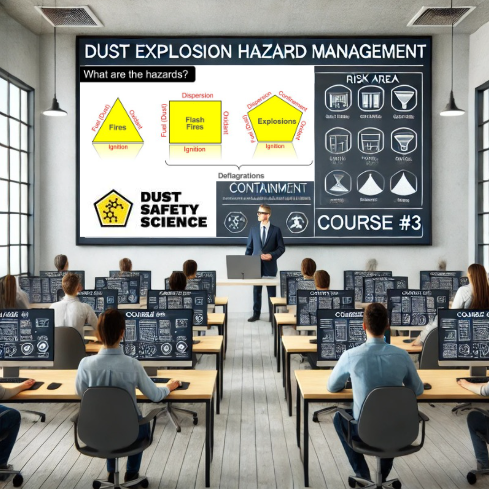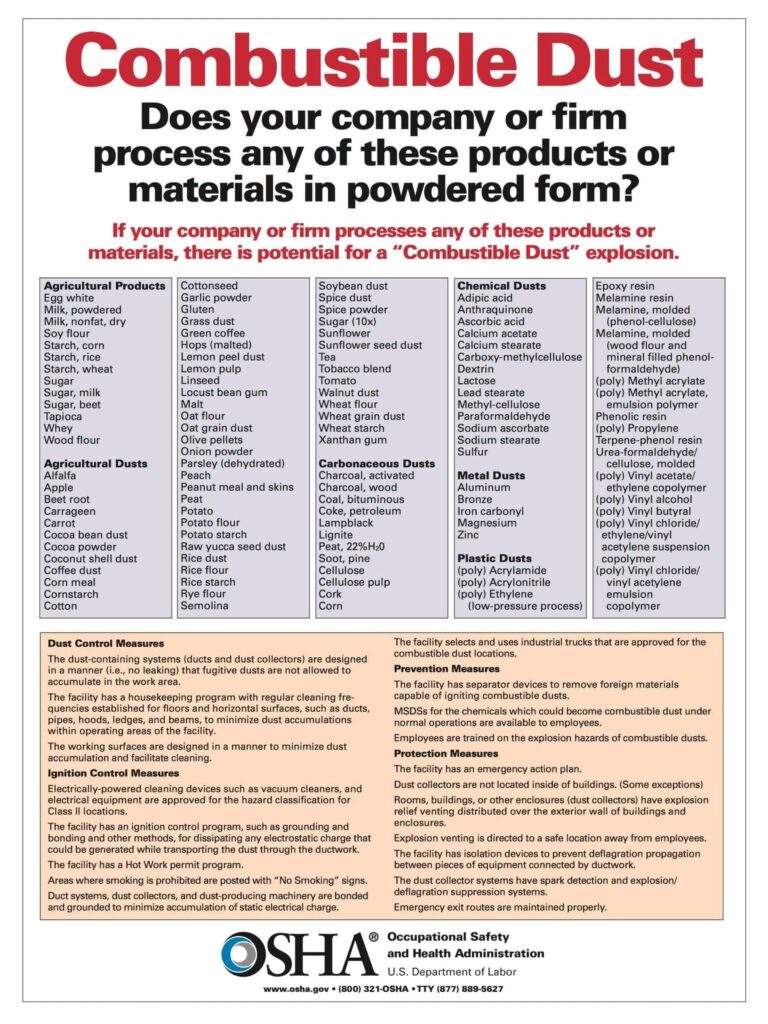Published December 12, 2024 Authored by Dr. Chris Cloney and Jon Barrett of Dust Safety Science

Combustible Dust Explosions: The Risks, the Root Causes, and Your Safety Training Solution
Every year, combustible dust explosions and incidents happen across all manufacturing industries, causing widespread destruction, injuries, and even loss of life. The financial toll is staggering, with billions in property damage and legal costs. Despite the risks, many industrial facilities and manufacturing plants must tackle the challenges of combustible dust hazards.
The question is: Are you doing enough combustible dust training and online training to protect your business and employees? To take the first step toward a combustible dust training course with online training, and creating a safer workplace, visit Dust Safety Science’s Combustible Dust Training, for the industry experts training course.
The Devastating Consequences of Dust Explosions
Combustible dust incidents don’t just cause physical damage, they devastate lives. Combustible dust can be found in many industrial settings and comes in different forms. The dust suspended in the air in the right concentration can create an explosion, resulting in the potential for flash fire, and secondary explosion hazards. Workers face injuries or fatalities, businesses lose productivity, and the aftermath often leads to reputational damage and regulatory fines. To address this hidden threat and explosion hazards, proactive online training is essential. Enter Dust Safety Science’s combustible dust safety training, an online training course game changer in industrial training.
Combustible Dust Safety Training: A Necessary Defense
Combustible dust training at your job site empowers businesses to identify, control, and mitigate combustible dust hazards. A well-structured training program and course ensures compliance with standards, enhances workplace compliance, and promotes operational efficiency, from combustible dust hazards.
To take the first step toward combustible dust training, and creating a safer workplace, visit Dust Safety Science’s Combustible Dust Training training course. Dust Safety Science’s comprehensive combustible dust training course, on-demand online training course, industry experts, and solutions equip organizations to handle combustible dust risks effectively.
Understanding Combustible Dust Explosions
What is Combustible Dust?
Combustible dust is made of fine particulate solids that can ignite and explode when dispersed in the air, in the right concentration, and can create explosion hazards. These particles, ranging from wood shavings to powdered metals, form an explosive mix under certain conditions and when conditions are optimum. Combustible dust can result in the potential for flash fire, and secondary explosion hazards.
The Dust Explosion Pentagon identifies five critical elements required for a dust explosion:
- Fuel: Combustible dust.
- Oxygen: Present in the air.
- Ignition Source: Heat, sparks, or flames.
- Dispersion: Particles suspended in air.
- Confinement: Enclosed spaces that amplify explosive force.
When all five elements converge, the results can be catastrophic.
Industries at Risk of Combustible Dust Explosions
While combustible dust hazards exist in many industries, some industries are more prone to combustible dust explosions than others:
- Food Processing: Flour, sugar, and grain dust.
- Woodworking: Sawdust and fine wood particles.
- Pharmaceuticals: Fine powders and chemicals.
- Biomass: Wood, wood residues, energy crops, agricultural residues including straw, peat, and organic waste from industry and households.
- Coal: Coal dust and Coking coal dust
- Metalworking: Aluminum, magnesium, zirconium, and other metallic dust.
Each industry requires customized training to manage unique risks. Learn how tailored training can address these challenges by visiting Dust Safety Science’s Training Page.
Why a Combustible Dust Training Course is Crucial
Regulatory Compliance
Regulatory agencies like OSHA and standards like NFPA 652 mandate measures to control combustible dust risks under certain conditions at your job site. Failure to comply not only endangers lives but also leads to penalties. Combustible dust training and an online training course can assist organizations in staying compliant and avoiding legal consequences, at your job site.
Risk Mitigation
Identifying and mitigating dust hazards is central to a safe work environment. Combustible dust training and an online training course, such as those offered by Dust Safety Science, provide actionable insights to reduce risks through Dust Hazard Analyses (DHA) and preventive strategies.
Employee Safety
Education is key to empowering workers. Through a training course, employees learn to:
- Recognize Combustible Dust Hazards.
- Use properly rated, Combustible Dust Control Equipment, such as Dust Collectors, Dust Control Fans, and Combustible Dust rated Vacuums.
- Use personal protective equipment (PPE) effectively.
- Follow emergency procedures during incidents.
Operational Efficiency
Preventing explosions reduces downtime, maintains productivity, and saves costs associated with accidents. A proper dust explosion training course ensures smoother operations and a safer workplace.
Core Elements of Combustible Dust Safety Training
Dust Hazard Analysis (DHA)
A Dust Hazard Analysis, DHA, is the cornerstone of dust awareness. A Dust Hazard Analysis involves identifying hazardous zones, evaluating risk severity, and implementing control measures. Training ensures participants can conduct effective DHAs for their facilities.
Housekeeping and Maintenance
Dust accumulation poses a significant risk. Training covers:
- Effective cleaning techniques to minimize airborne dust.
- Preventive maintenance schedules for equipment.
- Targeting hard-to-clean areas where dust tends to settle.
Ventilation and Dust Collection
Proper ventilation and dust collection are critical to control dust at its source. Training addresses:
- Designing effective dust collection systems.
- Ensuring ongoing system inspections and maintenance.
- Educating staff on the proper use of dust collection equipment.
Ignition Source Control
Ignition sources are often preventable. Training programs focus on:
- Identifying ignition risks, such as open flames, hot surfaces, and electrical faults.
- Implementing spark detection and suppression systems.
- Using explosion-proof equipment in high-risk areas.
Emergency Response Planning
When an incident occurs, preparedness can save lives. Training equips workers with:
- Evacuation procedures and drills.
- Fire suppression strategies.
- First aid skills to handle injuries effectively.
Invest in these essential safety components by enrolling in Dust Safety Science’s Combustible Dust Training.
Why Choose Dust Safety Science for Combustible Dust Training?
Comprehensive Curriculum
The training program delves deep into every aspect of combustible dust awareness, from understanding explosion mechanics, and management systems, to advanced mitigation techniques. Learn more at Dust Safety Science’s Training Page. Upon successful completion of a course or the course series, participants will be prompted to download the certificate of completion directly from the course site.
Expert Instructors
With a team of seasoned professionals, Dust Safety Science brings unparalleled expertise. The Dust Safety Science instructors ensure participants receive actionable, industry specific guidance.
Flexible Training Options
Choose a format that fits your needs:
- Online Courses: Flexible and accessible.
- In-Person Training: Hands-on experience for practical learning.
- Hybrid Options: A blend of convenience and interactivity.
Customized Training Solutions
Every industry faces unique challenges. Dust Safety Science offers tailored training solutions, that address specific risks and compliance needs. Start customizing your training course today by visiting Dust Safety Science’s Training Page.
Take Action: Ensure Your Facility’s Safety Today
Combustible dust is an invisible threat with potentially devastating consequences. Comprehensive safety training is not optional, it’s a necessity. Protect your workforce, reduce risks, and ensure regulatory compliance by investing in a professional training course.
Start your journey toward a safer workplace today by enrolling in Dust Safety Science’s Combustible Dust Safety Training. Learn more about the programs and how they can benefit your organization, and determine if you are a good fit for the course and program.
Don’t wait until it’s too late. Visit Dust Safety Science’s Training Page to register for a course and secure your facility’s future.

A picture of the OSHA Combustible Dust Poster, and Materials that Create Dust in a Manufacturing Facilities
About Dust Safety Science
Dr. Chris Cloney, of Dust Safety Science, provides additional information on Combustible dust explosion training, with a Podcast. Click on the latest Podcast Links: How to Run Effective Dust Explosion Training Sessions

A picture of Dr. Chris Cloney, an Expert on Combustible Dust Hazard Analysis
Resources:
Visit: Dust Safety Science Training Course
Visit: Fire and Explosion Protection Equipment Providers
Visit: Risk Assessment & Dust Hazard Analysis Providers
Visit: Combustible Dust Testing Providers
Visit Dust Safety Science (Global Incident Tracking)
Visit Dust Safety Academy (Resources, Training, and Events)
Visit Dust Safety Professionals (Need Help? Get Support Today!)
Visit Dust Safety Journal for the Dust Safety Science Monthly Journal
Subscribe to our FREE, Dust Safety Science Newsletter at Dust Safety Science Newsletter
Visit the Dust Safety Science blog for written articles on combustible dust safety including the latest research, expert opinions, and state-of-the art in fire and explosion protection.
